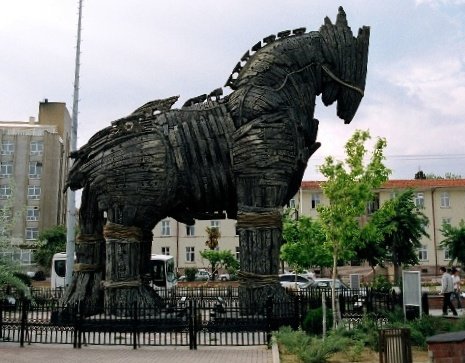Imagine for a moment the city of Troy, its walls towering, the air thick with tension and the scent of sea salt, as a massive wooden horse stands silent at its gates. Was this incredible story of cunning and conquest just a brilliant piece of fiction, or did something like the Trojan Horse truly rumble across the dusty plains of ancient Anatolia? The mystery of the Trojan Horse is one that has haunted historians, scientists, and storytellers for centuries. What if behind the poetry and legend, there lies a kernel of truth, waiting to be unearthed? Let’s journey into the heart of an age-old enigma, peeling back layers of myth, exploring ancient ruins, and delving into the minds of those who seek the truth behind the most famous trick in all of history.
The Allure of the Trojan Horse Legend

The story of the Trojan Horse is more than just a tale; it’s a symbol of human ingenuity and deception. For thousands of years, this story has captivated listeners, evoking awe and even fear at the cleverness it represents. The idea that a simple wooden structure could bring down mighty Troy stirs up emotions—admiration, suspicion, and even disbelief. Why has this legend endured? Perhaps because it touches on something universal: the fear that what seems harmless can sometimes be deadly. The horse is not just a vessel; it’s a warning, an icon, and a challenge to our sense of security.
Homer’s Iliad and the Power of Epic Poetry

Although the Iliad is the most famous account of the Trojan War, Homer’s epic poem actually ends before the horse makes its entrance. Still, its shadow lingers over the closing lines, leaving the audience hungry for what happens next. The Odyssey, also attributed to Homer, fills in more details, mentioning the horse in passing but never dedicating lines to the mechanics of the deception. This poetic vagueness gives the horse a mythic quality, as if it hovers just outside the bounds of reality, tantalizing readers with the possibility that it could have happened.
Virgil’s Aeneid: Expanding the Tale

Centuries after Homer, Virgil picked up the story in his Aeneid, providing the most detailed ancient account of the Trojan Horse. His vivid descriptions—Greeks hidden inside, Trojans dragging the horse into their city, the tragic downfall—helped cement the myth in Western imagination. Virgil’s version is more than just a story; it’s a master class in narrative suspense and tragedy. Yet, Virgil wrote with the benefit of hindsight, weaving Roman ideals and propaganda into his tale. That means the account is as much about Rome as it is about Troy, raising questions about how much is history and how much is creative flourish.
Archaeological Evidence: Digging into Troy

The ruins of Troy, discovered in modern-day Turkey, provide tantalizing hints but no definitive answers. Archaeologists have uncovered layers of destruction, burned walls, and remnants of a city that was clearly besieged and rebuilt multiple times. But there’s no sign of a wooden horse—no charred timbers, no elaborate carvings, nothing to confirm the tale outright. Still, the evidence of warfare and sudden catastrophe lines up with the broader story, making it hard to dismiss the possibility that something extraordinary happened here.
The Science of Siege Warfare
Ancient siege warfare was brutal and creative, often relying on cunning as much as brute force. The Greeks and Trojans were known for their use of deception—false retreats, ambushes, and surprise attacks. The Trojan Horse, whether literal or metaphorical, fits perfectly into this tradition. Engineers and historians today marvel at the technical challenges of building such a large structure and smuggling soldiers inside. Would it have been possible? With enough determination and resources, perhaps. Even if the horse never existed, the idea reflects the inventive spirit of ancient military minds.
Symbolism and Metaphor: More Than Just Wood

To many scholars, the horse may never have been real. Instead, it could represent a metaphor for betrayal, a symbol of hidden dangers lurking inside gifts or peace offerings. In ancient cultures, horses were seen as powerful, almost mystical creatures, and using one as a vessel for destruction would have resonated deeply. The phrase “Trojan Horse” has survived for millennia because it captures this essential tension between appearance and reality—a theme as relevant today as it was in the Bronze Age.
Ancient Greek Storytelling Traditions

Oral tradition played a huge role in keeping the story of the Trojan Horse alive. Before it was ever written down, bards and storytellers would have spun the tale around campfires, adding flourishes and embellishments with each retelling. This means that the story could have changed dramatically over time, growing more fantastical as it passed down generations. Much like a game of telephone, details would shift, heroes would become more heroic, and the horse itself might have started as something much smaller—or something entirely different.
The Role of Deception in Ancient Warfare
Deception was not just a trick; it was a respected art in the ancient world. The Greeks even had a word for cunning intelligence: “metis.” The story of the Trojan Horse highlights this cultural value, showing how brains could triumph over brawn. There are real examples from other battles where armies used clever ruses to win against the odds. The Trojan Horse, then, is not just a story—it’s a lesson about the power of wit, one that ancient Greeks would have taken to heart.
Mycenaean and Hittite Connections

The Greeks who fought at Troy were Mycenaeans, a civilization known for their advanced engineering and martial prowess. The Hittites, who ruled nearby Anatolia, left behind clay tablets that mention a city called “Wilusa,” which many believe is Troy. These records describe conflicts and alliances eerily similar to the stories in Homer’s epics. While the tablets don’t mention a wooden horse, they do confirm that Troy was a real place, and that wars were fought over it.
Possible Origins of the Horse Motif

Why a horse? Some researchers suggest the horse was a sacred animal to the Trojans, making it the perfect vessel for a deceptive gift. Others point to ancient siege engines called “battering rams,” sometimes decorated with animal motifs, which could have been mistaken for a horse in later retellings. Still others propose that the horse was a metaphor for an earthquake—Poseidon, god of both horses and earthquakes, was said to have destroyed Troy’s walls. The truth might be a blend of these theories, shaped by centuries of storytelling.
Technological Feasibility of the Wooden Horse

Could ancient Greeks really have built a hollow wooden horse large enough to hide soldiers? Engineers debate this fiercely. Some say it’s plausible, citing examples of large wooden ships and siege towers from the same era. Others are skeptical, pointing out the immense difficulty of construction and the logistics of hiding enough men inside. Recent experimental archaeology has shown that, with the right tools and motivation, ancient builders could have achieved remarkable feats—so perhaps the horse was not so impossible after all.
The Trojan Horse in Modern Science and Culture

Today, the phrase “Trojan Horse” has taken on a new life, especially in the world of computer science. Malicious software that disguises itself as harmless is called a Trojan Horse, a fitting metaphor for the original tale. The story has inspired countless books, films, and even psychological theories about trust and betrayal. Its influence reaches far beyond history, shaping the way we think about security, deception, and risk.
Psychological Impact: Trust and Suspicion

The Trojan Horse story taps into a deep-seated human fear: the idea that danger can come from unexpected places. It’s a lesson in skepticism, teaching us not to accept gifts—or peace—without question. Psychologists have used the story to explore themes of trust, vulnerability, and the way our minds process threats. In everyday life, the “Trojan Horse” effect shows up whenever we’re confronted with something that seems too good to be true.
Comparative Myths: Horses and Deception Worldwide

Surprisingly, the motif of a trick involving animals appears in many cultures. From the Norse tales of Loki’s shapeshifting horse to the Indian epic of the Mahabharata with its own tales of deception, the use of animals as instruments of cunning is widespread. This suggests that the Trojan Horse story is part of a much larger pattern in human storytelling, one that crosses borders and eras.
Unraveling the Layers of Myth and Fact

Separating myth from fact is a tricky business, especially when dealing with stories thousands of years old. Historians sift through archaeological finds, ancient texts, and even geological records in search of clues. Every new discovery raises more questions: Was there a single event that inspired the story, or is it a patchwork of different battles and ruses? The uncertainty adds to the allure, inviting each generation to come up with its own answers.
The Trojan Horse as a Cautionary Tale

At its core, the story of the Trojan Horse is a warning. It urges us to look beneath the surface, to question what seems obvious, and to remember that the cleverest tricks are often the simplest. In a world filled with uncertainty and hidden threats, the tale is as relevant now as it ever was. It challenges us to stay vigilant and to never stop questioning the stories we are told.
The Enduring Mystery of Troy’s Fall

Despite centuries of study, the question remains: How did Troy really fall? Was it brought down by brute force, trickery, or a blend of both? The lack of concrete evidence hasn’t stopped people from searching, and new technologies like ground-penetrating radar and DNA analysis promise to offer even more insights in the future. The mystery endures, proving that some stories are simply too compelling to let go.
Popular Misconceptions and Modern Interpretations

Modern retellings often take creative liberties, adding details that have no basis in ancient texts. Movies might show the horse as a towering behemoth, while some books turn the Greek soldiers into near-superheroes. These embellishments can be fun, but they also blur the line between fact and fiction. It’s essential to approach the story with curiosity and a healthy dose of skepticism, recognizing that the truth may be stranger—or simpler—than we imagine.
New Discoveries and Future Perspectives

Every year, archaeologists and historians uncover new evidence that sheds light on the ancient world. Recent digs near Troy have revealed fresh clues about daily life, warfare, and the city’s final days. Advances in technology allow us to revisit old sites with new eyes, uncovering secrets that were hidden for millennia. The search for the real Trojan Horse continues, fueled by the hope that one day, we might finally separate legend from reality.
Reflections on History, Myth, and Human Nature

The Trojan Horse is more than just a story about war; it’s a mirror reflecting our deepest hopes and fears. It reminds us that history is not a fixed narrative, but a living tapestry woven from fact, fiction, and everything in between. Whether the horse was real or imagined, its legacy endures, challenging us to think critically, question bravely, and never underestimate the power of a good story.



